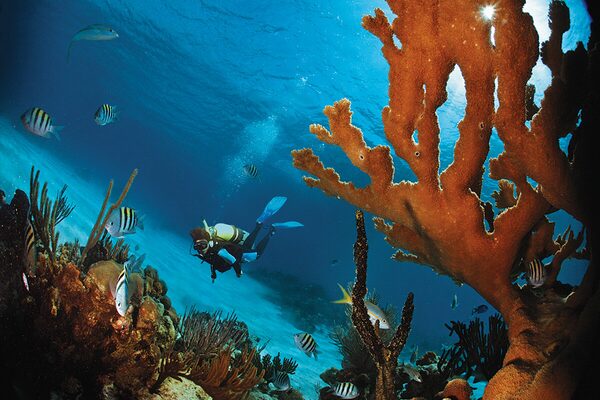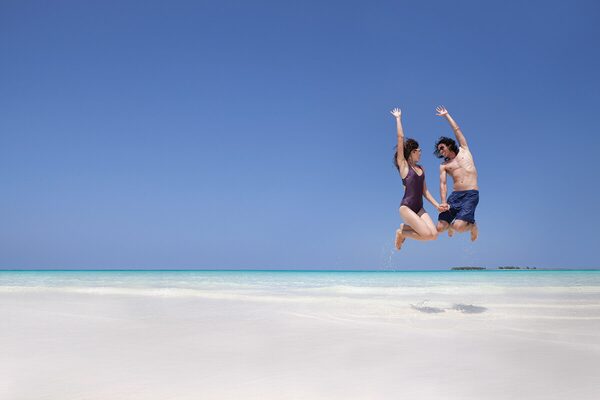World class reef diving is close to home

While away from the stress of life on land, you’re find lots of colourful company while diving Cienaga de Zapata, less than 150 kilometres southeast of Havana.Cuban Tourism Ministry
When you are 22-metres deep beneath the waves, there are no cellphones, no email alerts and no meetings to run to.
There’s nothing pressing other than the depths. Just you and your breathing. The air rushes in and as you slowly exhale out through your regulator - silver bubbles drift up to a golden faux-glass ceiling when the sun is shining on the ocean surface.
You are at peace. And that’s just the way it should be.
Diving in Cuba’s tropical waters - and exploring the myriad of coral reefs which are within easy reach compared to Australia’s Great Barrier Reef - is the perfect escape from the stresses of busy lives.
You just float, perfectly weightless and suspended, neither ascending nor descending as you cruise through the water concentrating only on your dive form and breathing. You’re thinking of your breathing rhythm, gently sipping that compressed air like a fine scotch, being economical with every movement to conserve energy and air to make the moments last.
Such is the Zen allure of Cuba’s underwater world; it is both surreal and real at once.
“The currents are not that strong so there’s not a lot of drift diving,” says Norbert Pietkiewicz, a dive shop owner and tour operator based in Richmond Hill, north of Toronto, who has run about 15 trips a year to Cuba over the last decade. “But the visibility is good, and the south side of the island is the Caribbean Sea, so it’s quite warm.”

A diver is dwarfed by a wreck near Santiago de Cuba.Cuban Tourism Ministry
Cuba, to many peoples’ surprise, is not a single monolithic land mass. In fact, it’s made up of more than 4,000 islands and cays spread over 109,000 square kilometres. That’s more than nearby Bahamas which are made up of 700 islands and cays over about 100,000 square kilometres.
It adds up to more than 5,500 kilometres of coastline from the northern shores on the Atlantic Ocean side to the southern coast and the Caribbean Sea. Not surprisingly, there’s a sizable amount of dive sites on both reefs and shipwrecks and almost all of them are fairly easy to access.
The Jardines De La Reina – the Queen’s Gardens - on the south coast is considered by many divers to be the finest Cuba has to offer and is full of great deep-sea fishing for bonefish, tarpon, snook, jack crevalle, barracuda, snapper and grouper in waters that average a comfy 25C between December and April.
The Queen’s Gardens are by far the most spectacular and often dubbed the Galapagos of the Caribbean. The uninhabited cays sit some 80 kilometres south of the main island, stretching 240 kilometres with mangroves and coral islands on top and a world of wonder below. It’s one of the longest barrier reefs in the world, some 140 kilometres long and up to 32 kilometres wide in parts. And it’s all a natural marine preserve.
That means taking time to organize your dream trip, says Mr. Pietkiewicz, as these sites are too far from shore to take a regular dive boat there and back and so the diving is by live-aboard boat.
That’s a treasured adventure for many people who like the idea of three dives a day and the social aspect of living on a large boat, moored at night on a sandbank or small cay. There’s even a floating hotel available which is roughly in the middle of the reef and allows for fast boat access to dive sites during the day. Night dives are even more spectacular since critters come out to play in shallow depths when the sun goes down.
There are a handful of live-aboard operators and boat sizes, along with costs, vary. For some divers the live-aboard experience is at the top of their must-do list, so there’s no shortage of divers from all over the world.
“It’s a secret”
— Canadian diving expert Norbert Pietkiewicz, on his personal hidden jewel of sites at Marea del Portillo, on the southwest tip of Cuba.
The diving is not only spectacular, it’s endless. It’s impossible to dive the entire reef in a week. You’ll want to check out Farallón with its massive pinnacles reaching up 20 meters from the bottom covered in all kinds of corals where fish frolic and eagle rays snooze on the sandy bottom. And it’s just one of the dive sites.
Also, on many scuba divers’ bucket lists are shark encounters, and there are no shortages of opportunities. Most common is the Caribbean reef shark – one of the more docile species – but Cuba has more than half the regional sharks found in and around the coastlines. In addition to the timid Caribbean reef sharks, there are bull sharks, blacktips, tiger sharks and nurse sharks.
For shark encounters on the north coast, Mr. Pietkiewicz says, head east past the resorts around Cayo Coco where Santa Lucia is a popular spot. There are some 30 dive sites along 32 kilometres of coastline, ranging from snorkel depth at five-metres down to beyond recreational diving capacity at 40-metres deep with some bull shark feedings at shipwreck sites.
For more advanced and adventurous divers the south coast along with the western and eastern tips are recommended. You’ll find good visibility and nice depths also with historic wreck diving, cenotes or caves, wall dives and, swim-throughs and canyons of coral full of marine life in every shape, colour and size.
Given Cuba’s rich history, of course, shipwreck also abound, from historic sites such as the USS Merrimac, which went down in 1898, to the famous Cristóbal Colón, which went to the bottom in the same year. Add to these sites, still, more modern ships stripped and sunk to create new coral reefs.

While divers will never want to surface, celebrating a little Cuban beach time is always in order.Cuban Tourism Ministry
It’s a thrill to slip in and out of these hulks and explore them on a dive, peeking into the sheltered spaces to see the dozens of large Caribbean lobsters which often live there while other fish swim in and out.
Mr. Pietkiewicz’ personal hidden jewel is Marea del Portillo on the southwest tip of Cuba, set in the Sierra Maestra National Park, which offers easy small boat access to lots of dive sites in the areas.
“It’s not known really for diving, so it’s a secret - but there are some great dives,” he says.
Rounding off the diving location is Canarreos Archipelago, off the southwest coast. It is made up of some 350 cays, the largest of which is Isla de la Juventud, also known as the Isle of Youth or Treasure Island. It was made famous by Robert Louis Stevenson who penned his seminal work there. The chances of finding lost trunks of pirate gold is slim, but there is certainly treasure all around.
Again, this area is isolated and sparsely populated, which is what attracted Stevenson, and, for those who truly seek some down time after going down underwater, it’s the perfect refuge.
If you’re planning a diving holiday, you’ll never get bored in Cuba on land or in the sea where the reef system seems endless.
And best of all, below those waves, cellphone reception is another world away.
Advertising feature produced by Globe Content Studio. The Globe’s editorial department was not involved.